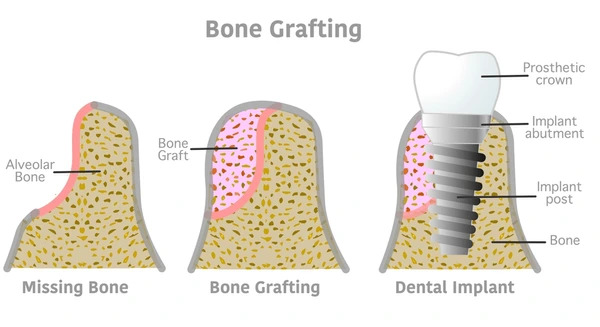Introduction: Dental bone grafting is a common surgical procedure performed to augment or regenerate bone in the jaw, typically in preparation for dental implants or to address bone loss resulting from injury, infection, or periodontal disease. This procedure has become integral in modern dentistry, allowing for the restoration of dental function and aesthetics in patients with compromised jawbone structure.
Procedure:
- Preparation: Before the procedure, the dentist or oral surgeon will thoroughly evaluate the patient’s oral health through clinical examination and imaging techniques such as X-rays or CT scans. This helps in determining the extent of bone loss and planning the grafting procedure accordingly.
- Graft Material Selection: Several types of graft materials may be used, including autografts (bone taken from the patient’s own body), allografts (donor bone from another individual), xenografts (bone from a different species, usually bovine or porcine), and synthetic materials. The choice of graft material depends on factors such as the patient’s medical history, the extent of bone loss, and the surgeon’s preference.
- Surgical Procedure: The patient is usually placed under local anesthesia, although sedation or general anesthesia may be used for complex cases or anxious patients. The surgeon will make an incision in the gum tissue to access the bone and prepare the recipient site for graft placement. The graft material is then placed and secured in position using screws, pins, or membranes to promote stability and integration with the surrounding bone.
- Healing and Integration: Over time, the body gradually replaces the graft material with new bone tissue through a process called osseointegration. This typically takes several months, during which the patient’s bone density improves, providing a solid foundation for dental implants or other restorative procedures.
Types of Bone Grafts:
- Autogenous Bone Grafts: Bone harvested from the patient’s own body, usually from the chin, jaw, hip, or tibia. Autogenous grafts are considered the gold standard due to their excellent integration and low risk of rejection.
- Allografts: Donor bone obtained from cadavers that undergoes rigorous processing to remove all cellular components while retaining the bone’s structural integrity. Allografts are widely used and eliminate the need for a second surgical site to harvest bone.
- Xenografts: Bone derived from animal sources, typically bovine (cow) or porcine (pig) bone. Xenografts serve as scaffolds for new bone growth and gradually resorb as the patient’s bone regenerates.
- Synthetic Bone Grafts: Biocompatible materials such as calcium phosphate ceramics or bioactive glasses that mimic the properties of natural bone. Synthetic grafts offer the advantage of predictable resorption rates and eliminate the risk of disease transmission associated with biological grafts.
Recovery and Aftercare:
- Patients may experience some swelling, discomfort, and bruising following the procedure, which can be managed with pain medication and cold compresses.
- It is essential to follow post-operative instructions provided by the dentist or oral surgeon, including proper oral hygiene practices and dietary restrictions to promote healing and minimize the risk of complications.
- Avoiding smoking and alcohol consumption during the recovery period is crucial, as these habits can impair healing and increase the risk of graft failure.
- Regular follow-up appointments will be scheduled to monitor healing progress and assess the need for additional treatments or modifications to the treatment plan.
Conclusion: Dental bone grafting plays a vital role in restoring oral health and function for patients with insufficient jawbone volume. With advancements in surgical techniques and graft materials, dentists and oral surgeons can achieve predictable outcomes and long-term success in dental implant placement and other restorative procedures. Effective communication between the patient and the dental care team is key to ensuring optimal results and patient satisfaction throughout the treatment process.

